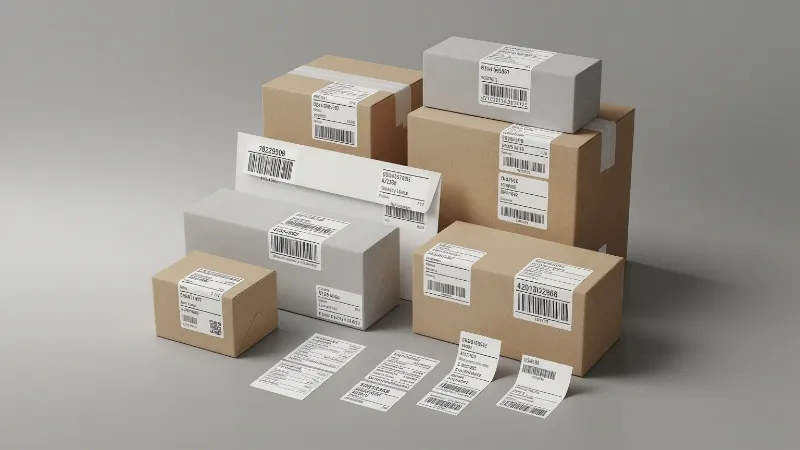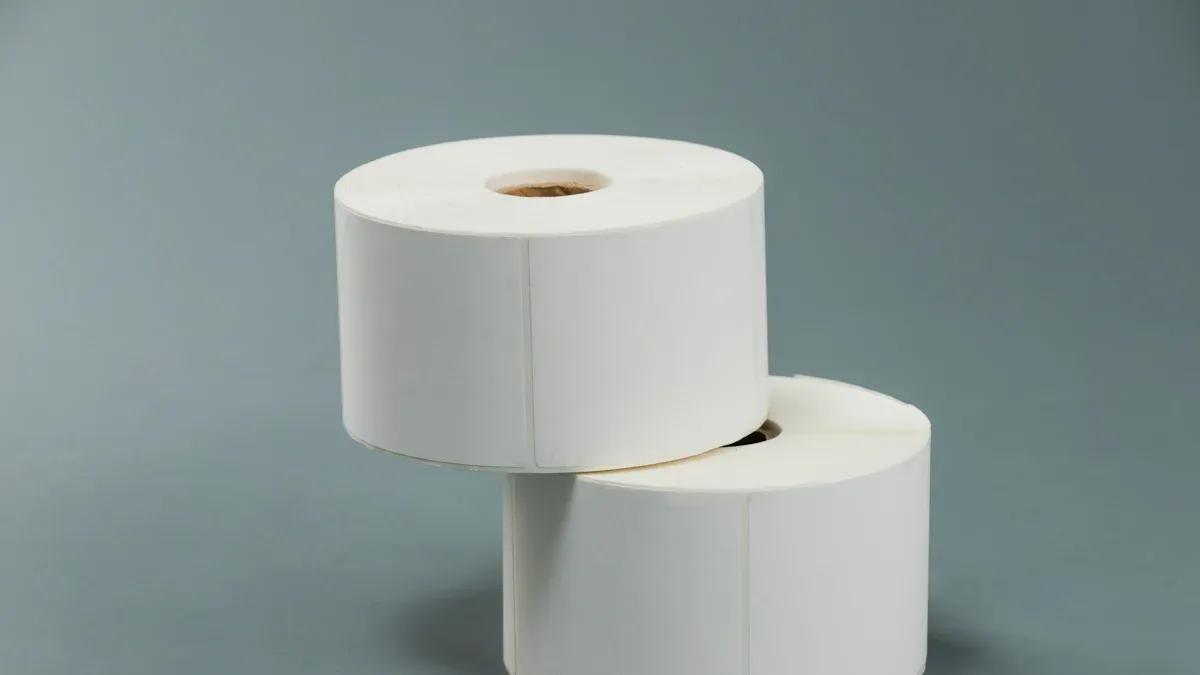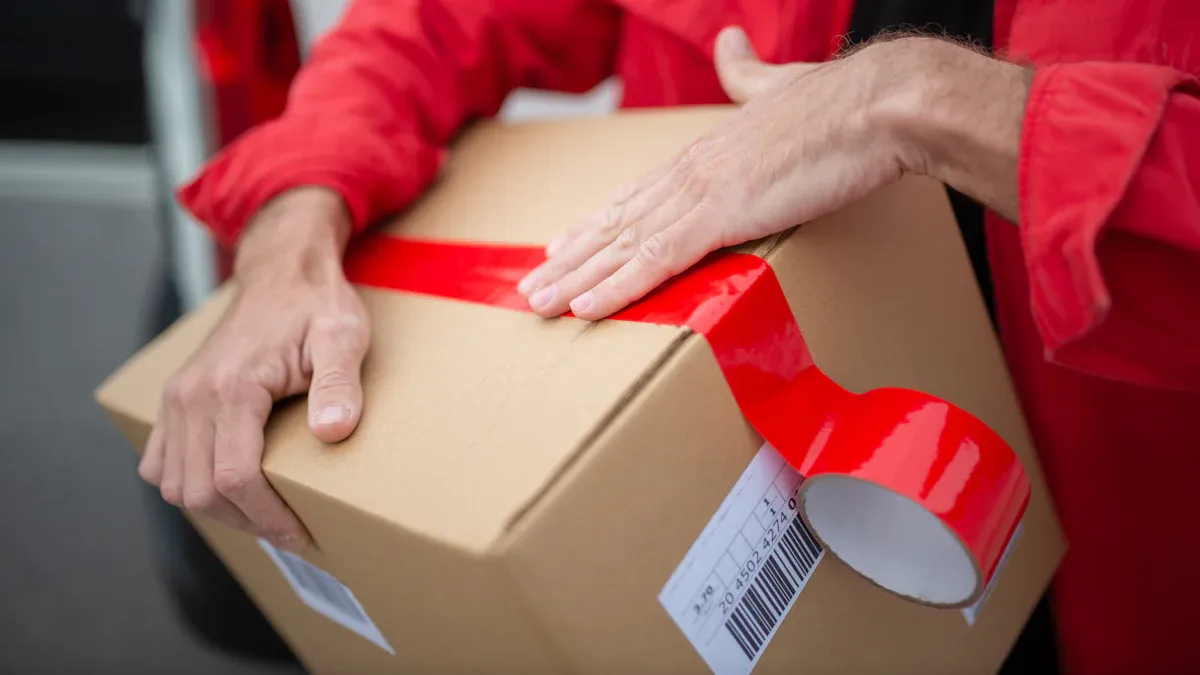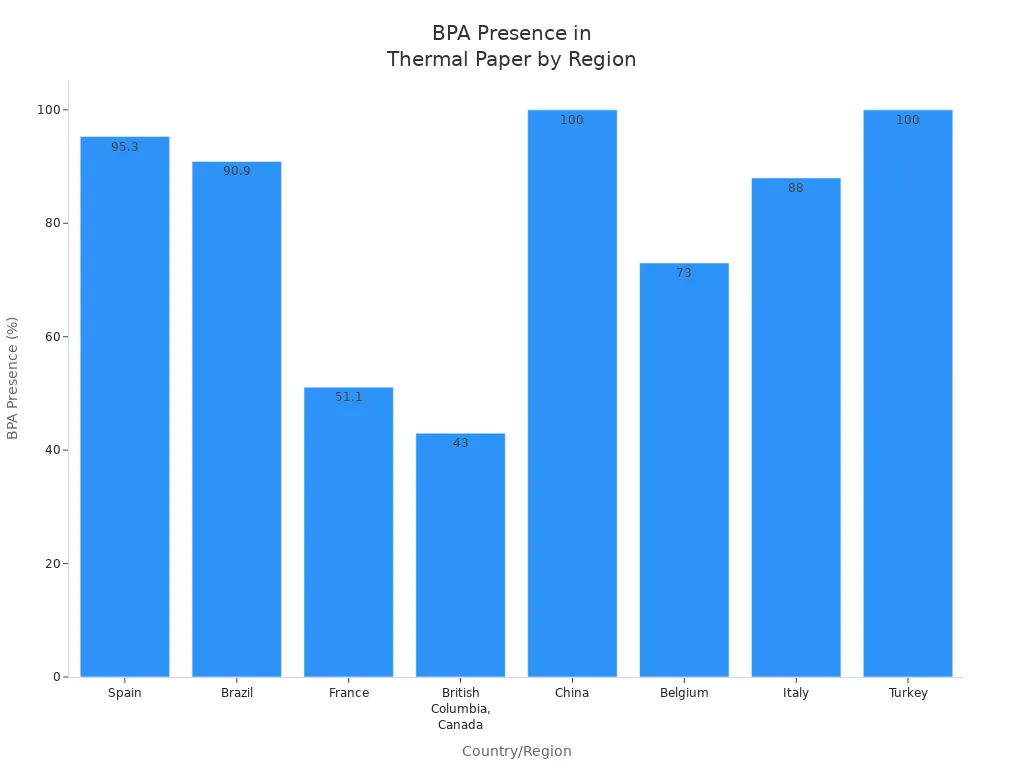
Thermal paper is good for most shipping labels. It prints fast and shows clear text. Barcodes on it scan easily. Many businesses pick thermal paper to save money. It does not need ink to work. Top companies look at some things when they choose thermal paper:
Print that is clear and does not smudge
How long it lasts in different places
If it is good for the earth and can be recycled
Suppliers you can trust and new technology
More online shopping and easy tracking make thermal paper popular now.
Key Takeaways
Thermal paper labels print fast, show clear text, and scan easily, making them great for most shipping needs.
Direct thermal labels work best for short-term shipping but can fade if exposed to heat, light, or moisture.
Using BPA- and BPS-free thermal labels helps protect your health and the environment.
Store labels in cool, dry places away from sunlight to keep them clear and readable longer.
Follow carrier rules and use the right label size and quality to avoid shipping delays and scanning problems.
How Thermal Paper Works

What Is Thermal Paper
You often see thermal paper when printing shipping labels. This paper changes when it gets hot. A thermal printer uses heat to make words or pictures. It does not need ink or toner. The paper has special chemicals inside. The table below explains what each part does:
Chemical Component | Role in Thermal Paper Image Formation |
|---|---|
Leuco Dyes | These dyes have no color at first. Heat makes them change color so you can see your label. |
Developers | These help the dyes react and show the image. Bisphenol A and Bisphenol S are common types. |
Sensitizers | These make sure the dyes and developers mix at the right heat. |
Stabilizers | These stop the image from fading too fast by keeping the dyes from turning back to no color. |
Thermal printers give you sharp, clear labels every time.
Direct Thermal Printing
Direct thermal printing uses heat to make images on the paper. You do not need ink, toner, or ribbons. This makes printing shipping labels fast and simple. Here are some main ways direct thermal and thermal transfer printing are different:
Direct thermal printers use heat to make images on the labels. You only need the special paper.
Thermal transfer printers use a ribbon with ink. The printer melts the ink onto the label.
Direct thermal labels are good for short-term use. They can fade if they get too hot, wet, or are in bright light.
Thermal transfer labels last longer and do not fade as fast, but you need to buy ribbons.
Thermal printer shipping labels help you save money and time. You also make less waste because you do not need extra supplies.
Uses in Shipping
People use thermal shipping labels every day in shipping and online stores. These labels are great for mailing, barcodes, and tracking. Many companies pick direct thermal labels because they cost less and are easy to print at work. You can print addresses, tracking numbers, and even logos. Thermal printer shipping labels stick to boxes, envelopes, and plastic bags.
Direct thermal printer labels help you keep up with fast shipping. You get clear, easy-to-scan labels. Thermal label printers help workers move faster on busy shipping days. In shipping, direct thermal label printing gives you a quick and steady way to handle packages.
Tip: Use thermal shipping labels for packages that will be delivered in six months or less. For longer storage or outside use, try other label types.
Pros and Cons of Thermal Shipping Labels

Durability and Fading
Thermal shipping labels work well for most packages, but you need to know how long they last. On average, these labels stay readable for 12 to 24 months if you store them in a cool, dry place. If you keep them away from heat, light, and moisture, they last longer. When you use them outdoors, they may only last about one month before fading. If you need labels to last more than six months, you should look at other options.
Exposure to heat, sunlight, or water can make thermal printer shipping labels fade or turn yellow. This fading can cause problems during shipping. If a label fades, the barcode may not scan, and the package could get lost. The table below shows how different conditions affect label durability:
Factor | Direct Thermal Labels | Thermal Transfer Labels |
|---|---|---|
Heat Exposure | Fades and damages quickly | Stays clear and readable |
Light Exposure | Turns yellow and fades in days or weeks | Remains readable for years |
Moisture | Breaks down and fades | Waterproof and strong |
Scratches | Scratches easily, barcodes may not scan | Tough and scratch-resistant |
Overall | Good for short-term, not for harsh conditions | Best for long-term and rough handling |
Tip: Never put tape over thermal shipping labels. Some tapes react with the label and cause smudging. This can make the barcode unreadable and delay delivery.
Print Quality and Scanning
You want every label to be clear and easy to scan. Thermal printer shipping labels give you sharp, smudge-resistant prints. This helps carriers scan your packages quickly and reduces mistakes. In busy warehouses, clear labels help automated systems sort packages faster. If a label is blurry or faded, the system may not read it. This can slow down delivery or even cause lost packages.
High-quality labels help you avoid scanning errors. When you use a good thermal printer and the right settings, your labels stay sharp and easy to read. This keeps your packages moving through logistics networks without delays. If you use poor-quality labels or printers, you risk delivery errors and unhappy customers.
Note: If you use the wrong tape or handle labels roughly, you may see smudging or fading. Always use quality materials and handle labels with care.
Cost and Efficiency
Thermal shipping labels save you money and time. Each label costs about $0.027, which is much less than laser labels at $0.07 per label. You do not need to buy ink or toner for a thermal printer, so you cut down on extra costs. This makes thermal printer shipping labels a smart choice for high-volume shipping.
You can print labels fast, which helps you keep up with busy days. Thermal printers work quickly and do not need much maintenance. You can print hundreds of labels in a short time. This speed helps your team process orders faster and keeps your logistics running smoothly.
Thermal shipping labels do not smudge easily, so your packages look professional.
You can connect your printer to shipping software for one-click printing.
Labels fit standard sizes used by major carriers, so you avoid problems with shipping.
🚚 Fast, clear, and low-cost labels help you meet deadlines and keep customers happy.
Health and Safety
BPA and BPS Concerns
When you handle thermal labels, you may come into contact with chemicals like BPA and BPS. These chemicals help create the image on the labels, but they can also pose health risks. BPA is an endocrine disruptor. It can affect your body in many ways:
It may increase the risk of heart disease, obesity, and diabetes.
It can cause problems with brain and reproductive development.
It may lead to breast and prostate cancers.
It can change thyroid function and harm the liver and kidneys.
It may cause hyperactivity and trouble learning.
You absorb BPA through your skin when you touch labels. Cashiers and people who handle labels often can have higher BPA levels in their bodies. BPS, which some companies use instead of BPA, can also cause similar health problems. Both BPA and BPS can move from the labels to your skin, especially if you handle many labels each day.
Children and pregnant women face higher risks from these chemicals. BPA and BPS can act like hormones in the body, which is dangerous during growth and development. You should try to limit your contact with labels that contain these chemicals.
Tip: Wash your hands after handling labels, and avoid touching your face or food until you do.
Safer Alternatives
You can choose safer options for your shipping labels. Many companies now offer bpa- and bps-free labels. These labels use new chemicals like ascorbic acid or special dyes that do not have the same health risks. Some brands use Blue4est technology, which is both bpa- and bps-free.
The chart below shows how common BPA is in thermal labels around the world:

You can see that many labels still contain BPA, but more bpa- and bps-free options are coming to the market. Some places, like Washington State, have banned all phenols in labels. The European Union has strict limits on BPA in labels, but some countries still have high levels.
To protect yourself, you can:
Use bpa- and bps-free labels for your shipping needs.
Pick digital labels or e-receipts when possible.
Handle labels as little as possible and wash your hands after use.
Ask your supplier if their labels are bpa- and bps-free.
If you use a lot of labels, you should look for bpa- and bps-free products. These labels help keep you, your workers, and your customers safer. They also help protect the environment from harmful chemicals.
Compliance and Best Practices
Carrier Requirements
Big shipping companies have rules for labels. UPS, USPS, and FedEx want you to use thermal printers. They like 4×6 inch labels because they fit most boxes. These labels also work well with scanners. Use labels with strong glue so they do not fall off. Carriers want barcodes and tracking numbers to be easy to read. If you use the wrong size or put tape on the barcode, your package might be late.
Carrier | Preferred Label Size | Printing Method | Notes |
|---|---|---|---|
UPS | 4×6 inches | Thermal printers recommended | Smudge-proof, strong adhesive |
USPS | 4×6 inches | Thermal printing recommended | Use carrier-approved label stock |
FedEx | 4×6 inches | Thermal printing recommended | High-quality, scannable labels |
Tip: Always look at your carrier’s website for the newest label rules and printer lists.
Handling and Storage
You can keep labels in good shape by following some steps. Store label rolls in a cool, dry room between 65°F and 75°F. Keep the air dampness between 45% and 55%. Do not let labels sit in sunlight or near heat. This stops them from fading. Use dark boxes or bins to block light. Stand label rolls up straight so they do not bend. Use old labels first by rotating your stock. Check labels often for fading, peeling, or damage. If you see problems, get new labels right away.
Store labels in rooms with steady temperature.
Use desiccants if the air is wet.
Write the type and date on each roll.
Look at labels before using to check print quality.
Note: Be gentle when you handle labels. Even small scratches can make barcodes hard to scan.
Direct Thermal Labels vs. Alternatives
Direct thermal labels are good for short-term shipping. They cost less and do not need ink or ribbons. You get clear words and barcodes for fast scanning. But these labels can fade if they get hot, wet, or too much light. For long trips or tough shipping, thermal transfer labels last longer. They use a ribbon to make prints that do not wash off or scratch easily. Laser labels are another choice, but you need special ones for shipping.
Feature | Direct Thermal Labels | Thermal Transfer Labels |
|---|---|---|
Cost | Lower | Higher |
Durability | Short-term | Long-term |
Print Quality | Sharp, high-definition | Also sharp, more resistant |
Environmental Sensitivity | High | Low |
Applications | Shipping, receipts | Harsh environments, inventory |
If your packages get rough handling or need to last, use thermal transfer labels. For most daily shipping, direct thermal labels save time and money.
You can trust thermal labels for most shipping jobs. They print quickly and help save money. These labels are good for lots of orders. Many companies pick labels that fit their shipping needs. Direct thermal labels are best for short-term use. They give clear prints and are easy to scan. If your packages get hot, wet, or travel far, use stronger labels. Always check if the labels stick well and print clearly. Pick BPA-free and recyclable labels to stay safe. Good labels help your packages move fast and keep customers pleased.
FAQ
Can you recycle thermal shipping labels?
Some thermal labels can be recycled, but not all of them. Many labels have chemicals that make recycling tough. Ask your local recycling center if they take these labels. Try to use BPA-free and recyclable labels for safer throwing away.
Do thermal shipping labels work in cold weather?
Thermal labels still work well when it is cold. You get clear prints even in chilly places. Keep the labels dry and do not let them freeze for best results.
Why do my thermal labels fade so quickly?
Heat, sunlight, or water can make labels fade fast. Store your labels in a cool, dry spot. Use them within six months to keep the print looking good.
Are thermal shipping labels waterproof?
Most thermal labels can handle small spills, but they are not fully waterproof. Water can make them fade or smudge. For wet places, pick waterproof or thermal transfer labels.
